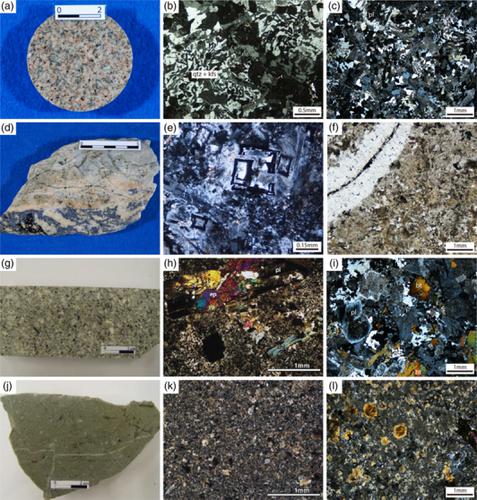当前位置:
X-MOL 学术
›
Resour. Geol.
›
论文详情
Our official English website, www.x-mol.net, welcomes your
feedback! (Note: you will need to create a separate account there.)
A study of igneous rocks related to Zn–Pb mineralization in the Shinyemi and Gagok deposits of the Taebaeksan Basin, South Korea
Resource Geology ( IF 1.1 ) Pub Date : 2020-01-21 , DOI: 10.1111/rge.12230 Jieun Seo 1 , Seon‐Gyu Choi 1 , Minho Koo 2 , Chang Whan Oh 3 , In–Chang Ryu 4 , Gilljae Lee 5
Resource Geology ( IF 1.1 ) Pub Date : 2020-01-21 , DOI: 10.1111/rge.12230 Jieun Seo 1 , Seon‐Gyu Choi 1 , Minho Koo 2 , Chang Whan Oh 3 , In–Chang Ryu 4 , Gilljae Lee 5
Affiliation

|
The Shinyemi and Gagok deposits, located in the Taebaeksan Basin, South Korea, display Zn–Pb mineralization along a contact between Cretaceous granitoids and Cambrian–Ordovician carbonates of the Joseon Supergroup. The Shinyemi mine is one of the largest polymetallic skarn‐type magnetite deposits in South Korea and comprises Fe and Fe–Mo–Zn skarns, and Zn–Cu–Pb replacement deposits. Both deposits yield similar Cretaceous mineralization ages, and granitoids associated with the two deposits displaying similar mineral textures and compositions, are highly evolved, and were emplaced at a shallow depth. They are classified as calc‐alkaline, I‐type granites (magnetite series) and were formed in a volcanic arc. Compositional variation is less in the Shinyemi granites and aplites (e.g., SiO2 = 74.4–76.6 wt% and 74.4–75.1 wt%, respectively) than in the Gagok granites and aplites (e.g., SiO2 = 65.6–68.0 wt% and 74.9–76.5 wt%, respectively). Furthermore, SiO2 vs K/Rb and SiO2 vs Rb/Sr diagrams indicate that the Shinyemi granitoids are more evolved than the Gagok granitoids. Shinyemi granitoids had been already differentiated highly in deep depth and then intruded into shallow depth, so both granite and aplite show the highly evolved similar chemical compositions. Whereas, less differentiated Gagok granitoids were separated into two phases in the last stage at shallow depth, so granite and aplite show different compositions. The amounts of granites and aplite are similar in the Shinyemi deposit, whereas the aplite appears in an amount less than the granite in the Gagok deposit. For this reason, the Shinyemi granitoids caused not only Fe enrichment during formation of the dolomite‐hosted magnesian skarn but also was associated with Mo mineralization in the Shinyemi deposit. Zn mineralization of the Gagok deposit was mainly caused by granite rather than aplite. Our data suggest that the variation in mineralization displayed by the two deposits resulted from differences in the compositions of their associated igneous intrusions.
中文翻译:

韩国Taebaeksan盆地Shinyemi和Gagok矿床中与Zn-Pb矿化有关的火成岩研究
位于韩国太白山盆地的Shinyemi和Gagok矿床沿白垩纪花岗岩与朝鲜超寒武纪-奥陶纪碳酸盐之间的接触显示Zn-Pb矿化。Shinyemi矿山是韩国最大的多金属矽卡岩型磁铁矿矿床之一,包括Fe和Fe–Mo–Zn矽卡岩矿以及Zn–Cu–Pb替代矿床。两种矿床都产生相似的白垩纪成矿年龄,并且与这两种矿床相关的花岗石显示出相似的矿物质地和组成,并且高度演化,并位于浅层。它们被分类为钙碱性,I型花岗岩(磁铁矿系列),形成于火山弧中。Shinyemi花岗岩和and石中的成分变化较小(例如,SiO 2分别等于Gagok花岗岩和层状公寓中的74.4–76.6 wt%和74.4–75.1 wt%(例如SiO 2分别为65.6–68.0 wt%和74.9–76.5 wt%)。此外,SiO 2与K / Rb和SiO 2的关系与Rb / Sr的关系图表明Shinyemi花岗岩比Gagok花岗岩更进化。Shinyemi花岗岩类物质已经在深处高度分化,然后侵入浅层,因此花岗岩和胶结岩都显示出高度演化的相似化学成分。相比之下,分化程度较差的Gagok花岗岩在最后一个阶段浅层被分为两个阶段,因此花岗岩和橄榄岩显示出不同的成分。Shinyemi矿床中花岗岩和云母的数量相似,而云母矿的数量少于高戈克矿床中花岗岩的数量。因此,Shinyemi花岗岩不仅导致白云岩质镁矽卡岩形成过程中的铁富集,而且还与Shinyemi矿床中的Mo矿化有关。Gagok矿床的锌矿化主要是由花岗岩而不是云母引起的。我们的数据表明,这两个矿床所显示的矿化变化是由于其相关火成岩侵入物的成分不同所致。
更新日期:2020-01-21
中文翻译:

韩国Taebaeksan盆地Shinyemi和Gagok矿床中与Zn-Pb矿化有关的火成岩研究
位于韩国太白山盆地的Shinyemi和Gagok矿床沿白垩纪花岗岩与朝鲜超寒武纪-奥陶纪碳酸盐之间的接触显示Zn-Pb矿化。Shinyemi矿山是韩国最大的多金属矽卡岩型磁铁矿矿床之一,包括Fe和Fe–Mo–Zn矽卡岩矿以及Zn–Cu–Pb替代矿床。两种矿床都产生相似的白垩纪成矿年龄,并且与这两种矿床相关的花岗石显示出相似的矿物质地和组成,并且高度演化,并位于浅层。它们被分类为钙碱性,I型花岗岩(磁铁矿系列),形成于火山弧中。Shinyemi花岗岩和and石中的成分变化较小(例如,SiO 2分别等于Gagok花岗岩和层状公寓中的74.4–76.6 wt%和74.4–75.1 wt%(例如SiO 2分别为65.6–68.0 wt%和74.9–76.5 wt%)。此外,SiO 2与K / Rb和SiO 2的关系与Rb / Sr的关系图表明Shinyemi花岗岩比Gagok花岗岩更进化。Shinyemi花岗岩类物质已经在深处高度分化,然后侵入浅层,因此花岗岩和胶结岩都显示出高度演化的相似化学成分。相比之下,分化程度较差的Gagok花岗岩在最后一个阶段浅层被分为两个阶段,因此花岗岩和橄榄岩显示出不同的成分。Shinyemi矿床中花岗岩和云母的数量相似,而云母矿的数量少于高戈克矿床中花岗岩的数量。因此,Shinyemi花岗岩不仅导致白云岩质镁矽卡岩形成过程中的铁富集,而且还与Shinyemi矿床中的Mo矿化有关。Gagok矿床的锌矿化主要是由花岗岩而不是云母引起的。我们的数据表明,这两个矿床所显示的矿化变化是由于其相关火成岩侵入物的成分不同所致。











































 京公网安备 11010802027423号
京公网安备 11010802027423号